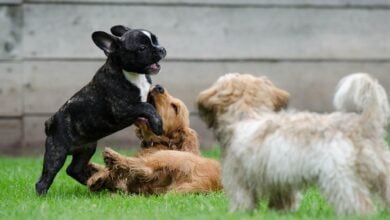From Chaos To Calm: Tackling 7 Common Puppy Behavior Problems
When you purchase through links on our site, we may earn a commission. Here’s how it works.
So, you brought home a fluffy bundle of chaos, congrats! Your shoes are now chew toys, your sleep schedule is shattered, and you’re suddenly Googling, “Is it normal for my puppy to scream at a leaf?” With all that cuteness comes a boatload of puppy behavior problems you may never have expected.
Table of Contents
Raising a puppy is magical… and mildly unhinged. But the truth is, many of those “bad” puppy behaviors? They’re totally normal. That doesn’t mean they’re harmless, left unchecked. They can snowball into habits that are harder to undo later.
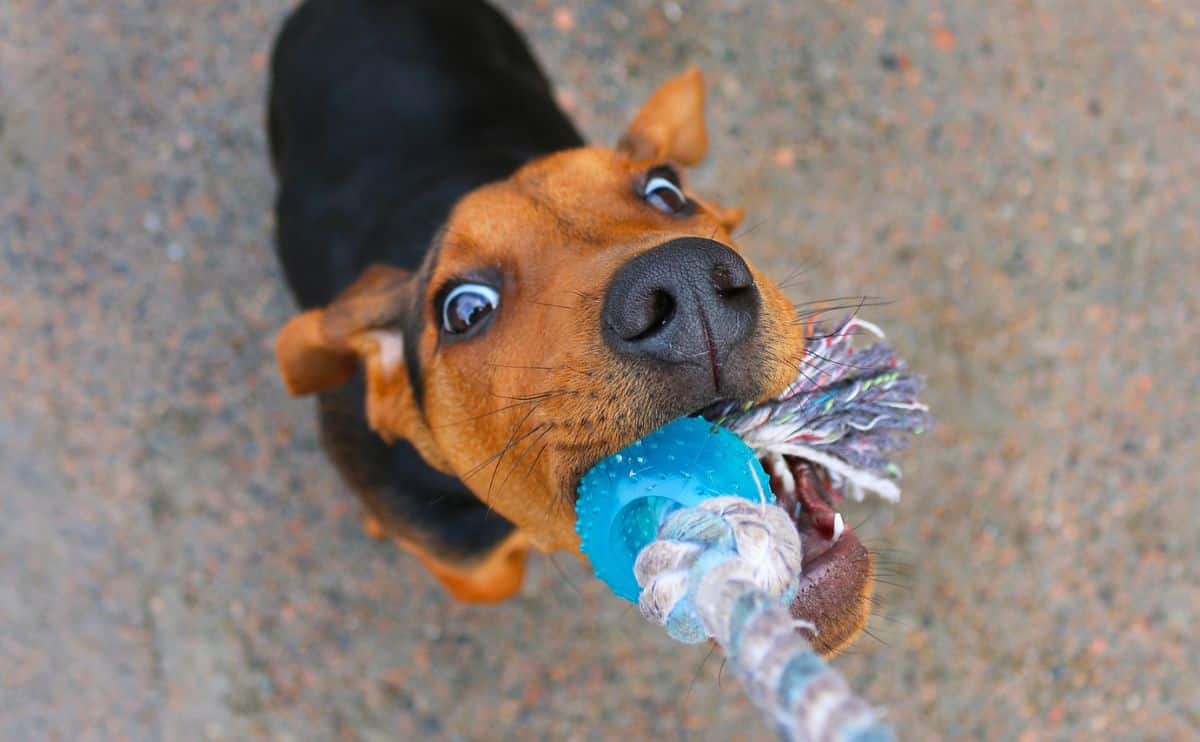
The good news? With patience, guidance, and the occasional frozen washcloth, you can help your pup learn what’s okay and what’s definitely not (like treating your arm like a chew stick). Let’s break down the most common puppy behavior problems and how to stop them before they drive you mad.
Understanding Puppy Behavior: Laying the Foundation for a Lifelong Bond
Bringing home a puppy is exciting. It also begins a critical stage in your dog’s development. How you respond to your puppy’s behavior during the early months will shape how they behave as an adult. Early guidance makes a big difference.
Puppy Developmental Stages
Puppies grow quickly, and their behavior changes just as fast. Each stage of development comes with new challenges and opportunities. Understanding what to expect at each age helps you respond appropriately and set your puppy up for success.
- Neonatal Stage (0 to 2 weeks) – Puppies cannot see or hear. They rely on their mother for warmth and food. No learning has taken place yet.
- Transitional Stage (2 to 4 weeks) – Eyes and ears begin to open. Puppies start to respond to sounds, smells, and light. Some basic sensory learning begins.
- Socialization Stage (3 to 14 weeks) – This is the most important stage of behavioral development. Puppies are curious and open to new experiences. Introduce your puppy to people, other animals, new environments, and different sounds. Early social experiences during this time reduce the chance of fear or aggression later. You can begin simple training like name recall, sit, and crate time.
- Juvenile Stage (3 to 6 months) – Your puppy starts exploring boundaries. Biting, chewing, jumping, and other common behavior issues begin. Teeth are coming in. Training needs to be consistent and frequent.
- Adolescent Stage (6 to 18 months) – Your dog may act defiantly or ignore commands. Hormonal changes and increased independence are normal. Continue reinforcing good behavior. Regression is temporary and expected.
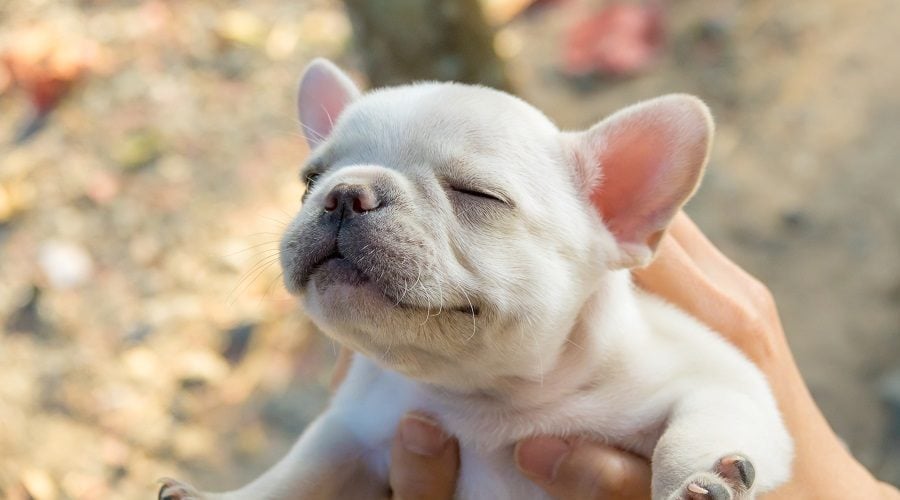
Why Early Training Matters to Prevent Puppy Behavior Problems
Training your puppy early helps prevent bad habits before they start. Behaviors that are repeated—even unintentionally, can become hard to change later. Teaching the proper habits from the beginning is more effective and less stressful for you and your dog. Early training also builds trust and communication.
When your puppy learns that paying attention to you brings rewards, they begin to look to you for guidance. This strengthens your bond and makes future behavior shaping easier.
Just as important, early training supports social development. Puppies exposed to a wide variety of people, places, and situations tend to be calmer and more confident as adults. According to the American Veterinary Society of Animal Behavior, proper socialization during the first few months significantly lowers the risk of fear-based issues later in life.
When you combine basic obedience with positive early experiences, you give your puppy a foundation for long-term learning, trust, and emotional stability.
7 Common Puppy Behavior Problems (And How to Fix Them Without Losing Your Mind)
Puppies are cute, chaotic, and completely clueless about the rules of being a “good dog.” From nipping your fingers to turning your favorite shoes into snacks, these early habits can spiral if you don’t step in.
Let’s walk through the most common puppy behavior problems, one by one, and break down exactly how to handle each without yelling, crying, or hiding in the bathroom.
1. Puppy Biting: Tiny Teeth, Big Problems
Puppy teeth may be small, but they come with one big lesson: your pup doesn’t know your skin isn’t a chew toy.
At first, it’s cute. That little gremlin is “mouthing” your hand like he’s sampling a snack. But as those needle-sharp baby teeth settle in, it starts to feel less like love and more like an ambush.
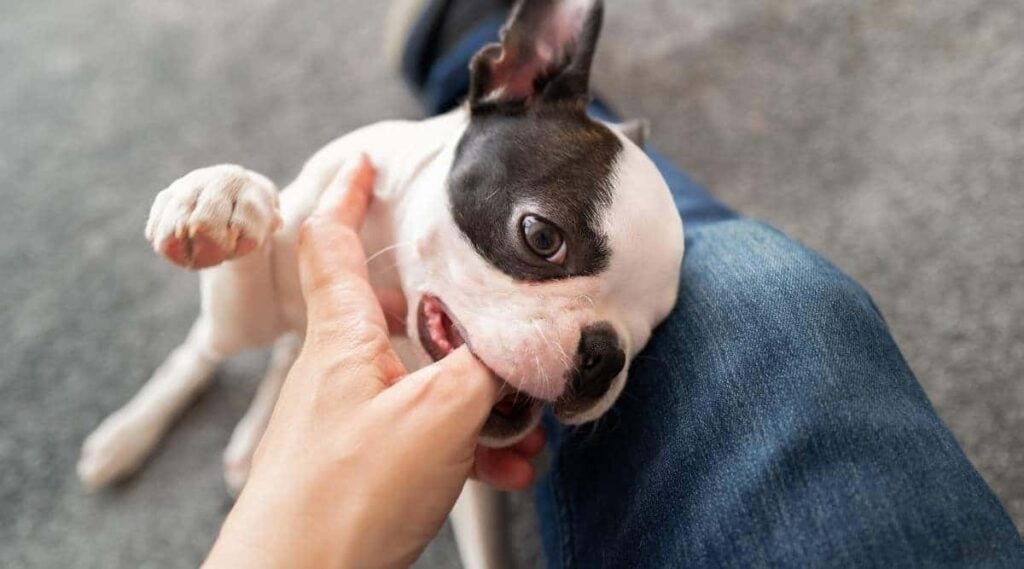
The truth? Biting is a normal part of puppy development. Puppies use their mouths to explore, play, and test boundaries. They’re not being aggressive. They’re being… well, puppies.
The second day after I brought Falkor home, a tiny, nervous little Poogle puppy with floppy ears and oversized paws, he bit me right on the face. I had leaned in to kiss the top of his head, and he panicked when a door slammed nearby. It wasn’t a little nip. It broke skin. It took weeks to heal fully.
But it wasn’t his fault. He had just left behind everything he knew: his mama and littermates, his space, his routine. He didn’t understand where he was or who I was. That bite wasn’t aggression. Fear, confusion, and instinct were tangled up in a ten-pound body with no idea how to ask for space.
Looking back, it’s almost funny. He looked more shaken than I was, his eyes wide like he couldn’t believe what he’d done. And that moment became the first real lesson in what puppyhood truly is. Messy. Tender. Full of mistakes on both sides.
And totally worth it.
– Danielle DeGroot, Rescue Dog Mom & Canine Journal Writer
Mouthing vs Biting: What’s the Difference?
- Mouthing is gentle nibbling without pressure. Think of it like tasting without chewing.
- Biting is when the pressure crosses the line and causes pain or breaks the skin. That’s where training comes in.
Your job is to teach your puppy bite inhibition and how to control the strength of his bite so it doesn’t hurt humans or other dogs.
5 Training Steps to Curb Biting
- Let them mouth, but set limits.
During play, let your puppy gently mouth your hand. The moment it gets too rough, give a loud, high-pitched “Ouch!” and let your hand go limp. - Pause the play and offer praise.
If your pup stops and looks startled or begins licking you (which is basically a puppy apology), praise him or her calmly and resume play. This teaches him, “Gentle gets attention. Rough ends the fun.” - Strike three, you’re out.
If he bites hard three times in 15 minutes, end playtime completely. Stand up, walk away, and ignore him for a short period. Silence is powerful. - Time-out if needed.
Still biting? After you yelp, turn away for 10 to 20 seconds. No eye contact, no talking. If it happens again, physically move away. When you return, invite gentle play again. - Level up the expectations.
Once he consistently stops biting hard, begin correcting even lighter bites. Gradually, you’ll only accept the gentlest mouthing or none at all.
Quick Notes
- Never yell or punish physically. It doesn’t teach bite control, just fear.
- Don’t pull your hand away fast. It can trigger the chase instinct.
- Avoid rough wrestling games that encourage biting behaviors.
Training a puppy not to bite takes patience, consistency, and sometimes a frozen washcloth for your own sanity. But teaching bite inhibition now helps your dog grow into a gentle adult who knows exactly how to keep his teeth to himself.
How To Stop Puppy Biting: A Common Puppy Behavior Problem (Video)
This video offers expert tips to tackle one of the most frustrating puppy behavior problems—biting. WARNING: This puppy is absolutely adorable and may convince you to get a puppy (or another one).
2. Puppy Chewing: Everything Is a Teething Toy (Including Your Couch)
Your puppy doesn’t hate your stuff. He just thinks your sneakers, phone charger, and baseboards are part of an interactive chew buffet made just for him.
Chewing is one of the most common puppy behavior problems, especially during the teething phase, which lasts for about six months. It helps relieve sore gums, burns off energy, and, unfortunately, turns your living room into a crime scene of shredded belongings.
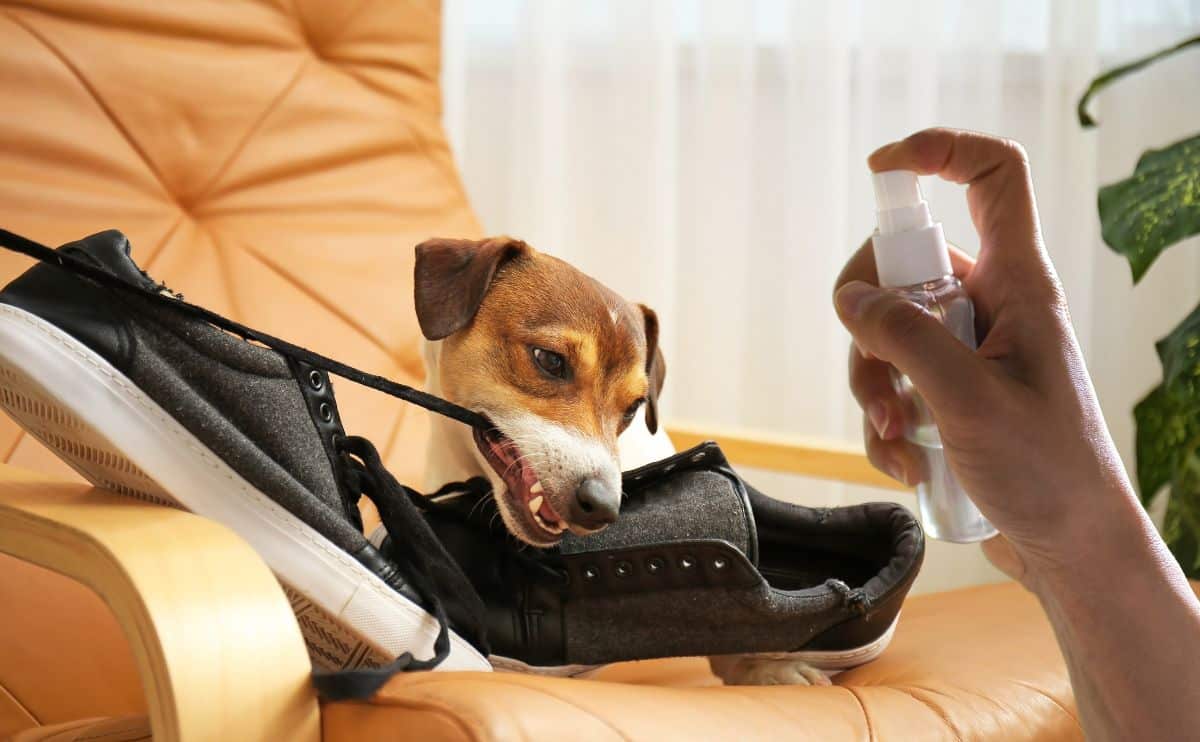
Why Puppies Chew
- Teething pain. Gnawing feels good on sore gums.
- Curiosity. Puppies explore the world with their mouths.
- Boredom. A tired puppy is a good puppy. A bored one is a tiny wrecking ball.
- Attention-seeking. If chewing gets a reaction, even a bad one, some puppies will double down.
7 Tips To Stop Chewing: Solving Puppy Behavior Problems at Home
So, how do you keep your pup from turning your house into a chew zone while still letting him be a dog? It’s all about prevention, redirection, and making the right things more fun to chew than your favorite sneakers.
- Puppy-proof your home.
Put shoes in the closet. Hide cords. Don’t leave earbuds, remotes, or glasses within snout’s reach. If it fits in a puppy’s mouth, it’s fair game in his mind. - Offer chew-approved alternatives.
Give your pup a designated chew toy, something that doesn’t look like household items. Avoid old shoes or socks. That just confuses the message. - Use a taste deterrent.
Sprays like Bitter Apple or lemon-scented deterrents can make furniture and shoes less appealing. Test a small patch first to make sure it doesn’t stain. - Freeze a washcloth.
Soak a clean cloth in water, wring it out, and freeze it. Offer it as a soothing chew during teething. Bonus: it’s budget-friendly and mess-free. - Interrupt, then redirect.
If he starts chewing the wrong thing, make a sharp sound like a clap or firm “No.” Then, calmly hand him his chew toy. The second he switches over, praise like he just won Best in Show. - Supervise and manage space.
Keep him on a leash indoors or in a puppy playpen when you can’t give full attention. Crate time can also help when he’s feeling especially chewy and wild. - Avoid the chase game.
If he grabs a forbidden item, don’t run after him. That turns it into a fun game. Instead, trade him for a high-value treat and keep your tone calm and boring.
Chewing is one of the messiest puppy behaviors but also one of the easiest to manage with prevention and consistency. Give your pup clear feedback, plenty of outlets, and a few frozen toys, and you’ll be past the worst of it before your third pair of shoes gets sacrificed.
Quick Fix
Caught your puppy chewing something he shouldn’t? Interrupt with a sharp clap or firm “No,” then offer a chew toy immediately. When he switches to the toy, praise him. Timing is everything. Reward the right choice the moment it happens. Read more tips on how to stop puppies from chewing.
3. Puppy Jumping: From “Aww” to “Oof, My Ribs”
It starts off innocent. Your tiny fluffball launches into your arms when you come home, tail wagging like a windshield wiper in a thunderstorm. You melt. You crouch and accept the love.
But one day, that same puppy is fifty pounds and flying at your chest like a furry cannonball. Suddenly, the welcome-home routine feels more like a wrestling match.
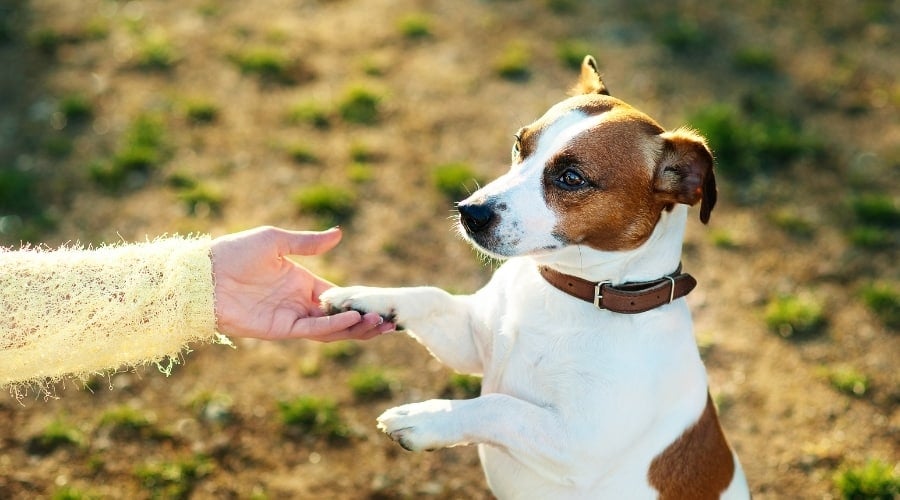
Jumping is cute at first, but it’s one of the most important habits to correct early, not just for your safety but for guests, kids, and that delivery driver who didn’t sign up for an aerial hug.
Why Puppies Jump
- Excitement overload. You walked through the door. It’s the best part of his day.
- Seeking attention. Any attention, good or bad, rewards the behavior.
- Scent targeting. Dogs greet each other nose-to-nose or, in some cases, nose-to-groin. We give off strong scents from our mouths and lower regions. It’s awkward, but it’s canine biology.
How to Teach “Four on the Floor”
- Ignore the chaos.
When you walk through the door, don’t look, touch, or talk to your pup if he’s jumping. No matter how hard it is, wait until all four paws are on the ground. Then, reward him with calm affection. - Reward calm behavior.
If he sits, stands still, or even stops jumping for a second, praise him and offer a small treat. Make it obvious that calm behavior leads to connection. - Don’t push him off.
Pushing may seem like correction, but for many puppies, it feels like fun. Instead, calmly turn your back or take a step away. - Train a replacement behavior.
Teach your pup to sit when greeting people. Practice short, focused sessions where you enter the room, ask him to sit, and only engage once he follows through. - Be consistent.
If one person in your home allows jumping, it sends mixed messages. Make sure everyone responds to jumping the same way, including family, friends, and even delivery folks.
It’s tough to ignore a puppy who’s overflowing with joy. But rewarding, calm, grounded greetings now save you from being tackled by your dog whenever you walk in the door.
Quick Fix
If your puppy jumps on guests, clip on a leash before opening the door. Step on the leash to limit jumping, and only allow greetings when all four paws are on the ground.
4. Potty Training Troubles: Managing One of the Most Frustrating Puppy Behavior Problems
Potty training is one of the first and most important lessons your puppy needs to learn. A clear, consistent routine helps your dog understand where and when to go. With patience, most puppies can learn quickly. But, some need a little more time and direction, and that’s ok.
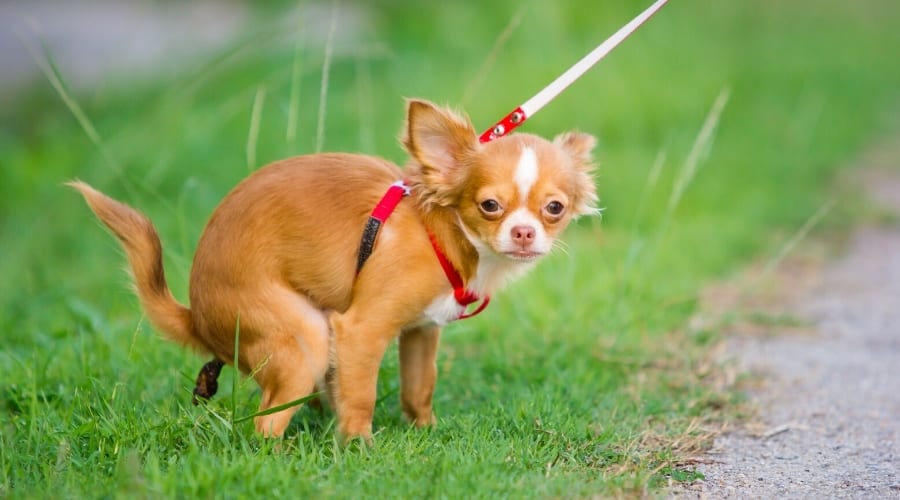
Common Puppy Potty Training Challenges
- Accidents in the house. This usually happens when the puppy is not taken out in time or doesn’t understand the rules yet.
- Peeing right after coming inside. Some puppies get distracted outside and don’t relieve themselves fully.
- Going in the crate. Crates that are too big or used inconsistently can cause confusion.
- Submissive or excited urination. Some puppies urinate when excited or nervous. This is common and usually resolves with time and confidence-building.
7 Puppy Potty Training Tips
Potty training is probably a pet parent’s number one priority. No one likes entering a room and stepping into something that shouldn’t be there. Here are a few tips to help house training your puppy go smoother.
- Take your puppy out frequently.
Young puppies may need to go out every 1 to 2 hours during the day. Always go out after meals, naps, and playtime. - Use the same spot each time.
Choose a consistent potty location. This builds a strong association with that area. - Praise them immediately after they go.
Reward your puppy right after they finish, not when they come back inside. - Keep a consistent schedule.
Feed at the same times daily. Predictable meals help regulate bathroom habits. - Supervise and limit freedom indoors.
Use baby gates or keep your puppy on a leash with you to prevent unnoticed accidents. - Clean accidents thoroughly.
Use an enzymatic cleaner to remove all scents. Avoid harsh punishment, which can delay progress. - Track progress.
Keep a log of when and where your puppy goes. This helps you predict patterns and catch early signs of regression.
Because this is such a detailed topic and highly requested, we’ve written a helpful article dedicated to housebreaking your puppy. You might also need pee pads for accidents, training spray to deter accidents, or consider upgrading to an indoor dog toilet of some sort for them to relieve themselves.
Quick Fixes
- Set a timer. Take your puppy out every 1–2 hours.
- Supervise closely. Use a leash indoors or limit access.
5. Understanding Puppy Whining: What This Behavior Problem Really Means
Whining is one of the main ways puppies communicate. It can mean a variety of things, from discomfort to anxiety. Identifying the cause helps you respond appropriately and avoid reinforcing the wrong behavior.
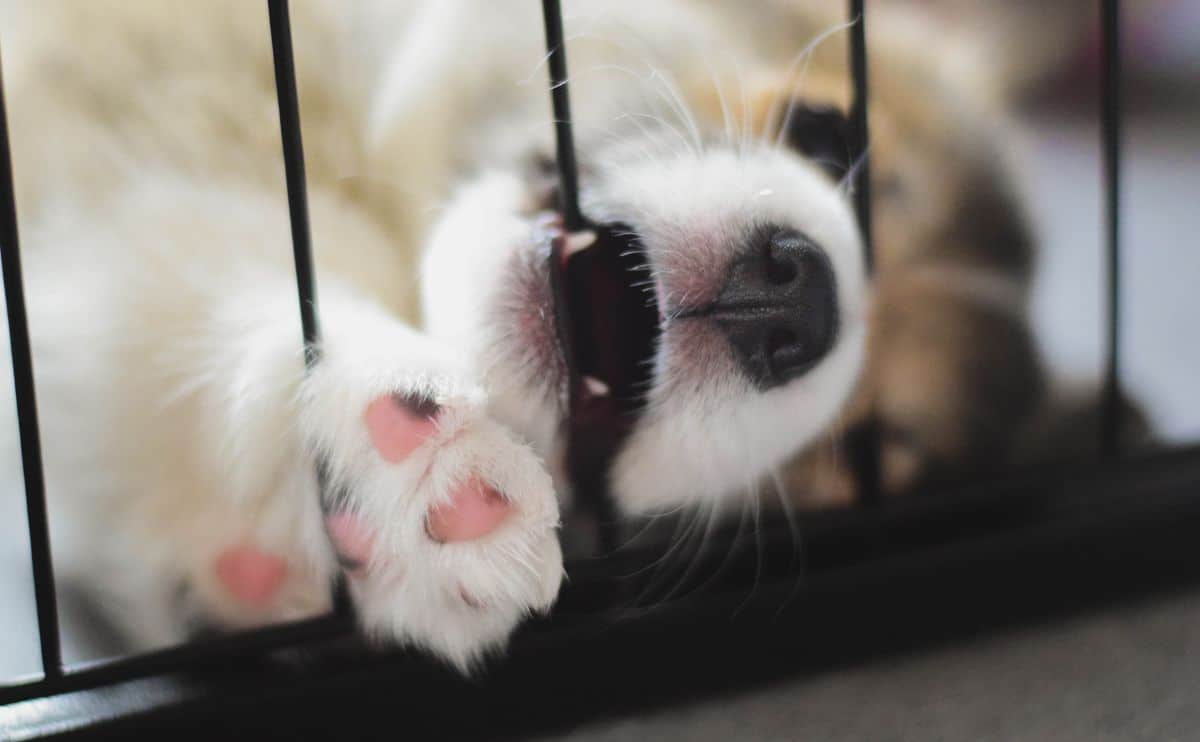
Why Puppies Whine
Why is your puppy whining? Does he need to go potty? Is he hungry? Has he had his walk? Does he need water? Did his toy get stuck under the couch?
- They need something. Hunger, thirst, or the need to go outside often causes whining.
- They want attention. Puppies may whine when left alone or when they’re bored and want interaction.
- They are uncomfortable. Crate discomfort, fear, or physical pain can also lead to vocalization.
- They are overtired. Too much stimulation without rest can cause puppies to become restless and vocal.
How to Respond to Puppy Whining
How you respond to whining matters and can set lifelong habits. Once you understand why your puppy is whining, you can take simple steps to manage it.
- Rule out basic needs.
Before correcting whining, make sure your puppy doesn’t need to go outside, is not hungry, and is in a comfortable environment. - Avoid giving in to demand whining.
If your puppy is safe and doesn’t need anything urgent, avoid picking them up or offering constant attention during whining. Quiet behavior should be rewarded instead. - Use crate training properly.
Make sure the crate is cozy and never used for punishment. A well-managed crate can reduce stress and whining over time. - Provide enough physical and mental stimulation.
Daily play, walks, and basic training help prevent boredom-related whining. - Encourage independent rest.
Teach your puppy to settle on their own. Use calm praise when they lie down or stay quiet. - Stay calm and consistent.
Reacting emotionally to whining can increase the behavior. Calm, consistent responses are most effective.
Understanding your puppy’s developmental stages, such as puppy fear periods, can help in addressing behaviors like whining by recognizing when your puppy might be more sensitive to new experiences.
Quick Fix
- Puppies feel more secure when they know what to expect. Set consistent times for meals, potty breaks, and bedtime.
- As hard as it is, don’t reward whining with cuddles or treats. Wait for quiet before giving attention.
- Make sure your pup isn’t whining due to hunger, needing the bathroom, or discomfort before correcting the behavior.
6. Nighttime Crying: Why It Happens and How to Help
It’s common for new puppies to cry at night. While it can be frustrating, this behavior is a normal part of adjusting to a new home. Understanding the causes can help you respond in a way that builds comfort and trust.
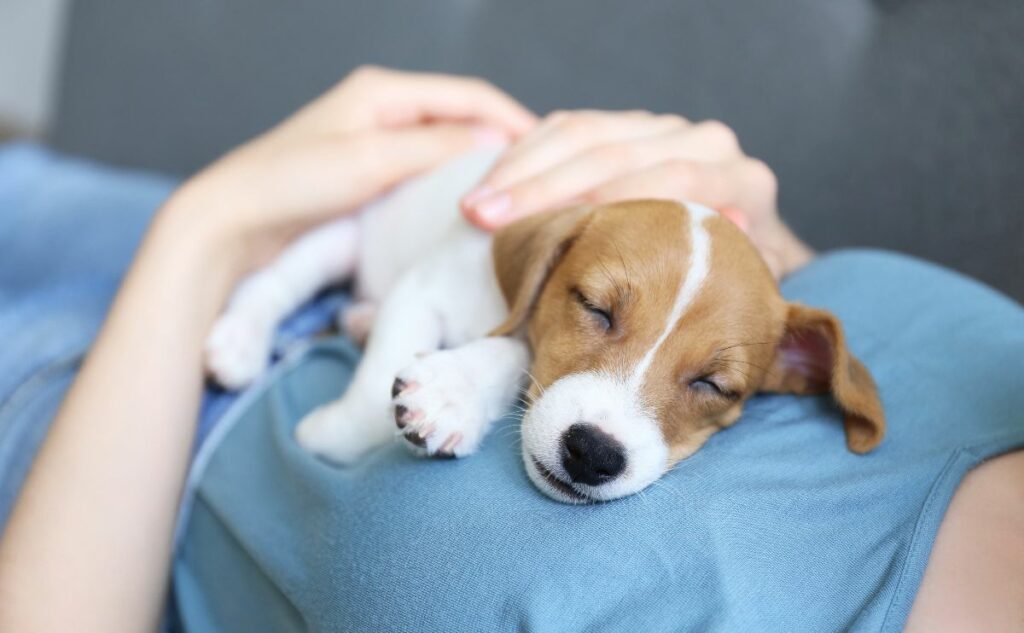
5 Reasons Why Puppies Cry at Night
Nighttime crying is one of the hardest parts of bringing a new puppy home. Your puppy isn’t being difficult; they’re scared, lonely, and unsure of their new surroundings. They’ve just left everything familiar behind. With patience, comfort, and consistency, you can help them feel safe and loved as they settle into their new life with you.
It helps to understand the most common reasons puppies cry at night to ease the transition.
- They feel lonely.
Puppies are used to sleeping close to their mother and littermates. Sleeping alone in a new environment can feel scary. - They are adjusting to a routine.
New surroundings, smells, and sounds can be overwhelming. It takes time for puppies to feel safe and settle into a routine. - They need to go to the bathroom.
Young puppies have small bladders and may need to go out during the night. - They are bored or have too much energy.
If a puppy doesn’t get enough exercise or stimulation during the day, they may be restless at night. - They are uncomfortable.
An unfamiliar crate or a drafty spot can cause discomfort and distress.
How to Help Your Puppy Sleep Through the Night
These simple steps can help make nighttime less scary for your puppy and more restful for you.
- Use a crate or a small sleeping area.
- A crate creates a cozy and secure space. It also helps with house training and prevents accidents.
- Keep the crate near your bed at first.
- Being close to you helps your puppy feel safe. Over time, you can gradually move the crate farther away if needed.
- Take them out right before bedtime.
- Make sure your puppy has a chance to go potty just before settling in for the night.
- Create a calming bedtime routine.
- Dim the lights. Offer a soft blanket or safe chew toy. Speak in a calm voice to signal that it’s time to wind down.
- Avoid giving attention to whining alone.
If you’ve ruled out bathroom needs and discomfort, avoid picking them up or talking too much. This can reinforce the crying. Be patient and consistent. Most puppies adjust within a few days to a few weeks. With a stable routine and calm reassurance, the nighttime crying will improve.
Quick Fixes
- Start the night calmly. Wind down playtime and stimulation an hour before bed.
- Keep the crate cozy and close. A soft blanket and your scent can help them settle.
- Use gentle reassurance. A quiet voice or short check-in can comfort without over-engaging.
- Don’t rush in for every whimper. Wait a moment to see if they self-soothe before stepping in.
- Celebrate small wins. Each quiet night builds their confidence and yours.
7. Hyperactivity in Puppies: What’s Normal and When to Intervene
Puppies have a lot of energy. Zooming around the house, jumping on furniture, or nipping during play is often part of normal development. But when that energy becomes constant or unmanageable, it may be a sign your puppy needs more structure.

What Causes Hyperactivity in Puppies?
Puppy energy can be a joy, but when it crosses into nonstop chaos, it’s time to look deeper. Understanding the root causes of hyperactive behavior can help you respond in a way that calms, not corrects.
- They are growing and learning. Puppies explore the world with their mouth and body. What may seem like chaos is often curiosity and normal energy.
- They are not getting enough exercise. Lack of physical activity can lead to pent-up energy. Puppies need regular movement suited to their breed and age.
- They are mentally understimulated. Bored puppies often act out. Without things to do, they may look for their own entertainment, like chewing or chasing.
- They are overtired. Just like toddlers, an overtired puppy may become wild and hard to calm. Puppies need frequent naps throughout the day.
- They have not learned how to self-regulate. Young dogs don’t know how to calm themselves down. This skill is learned over time with guidance.
How to Manage Puppy Hyperactivity: 7 Tips
Once you know why your puppy is bouncing off the walls, the next step is giving that energy a healthy outlet. Simple shifts in routine and structure can make a big difference in helping your puppy settle.
- Stick to a daily routine.
Predictable feeding, potty, and play times help regulate energy. Routines also reduce anxiety. - Provide age-appropriate exercise.
Short walks, safe games like fetch, and gentle training sessions help release energy. Avoid overexertion in very young puppies. - Use mental stimulation.
Food puzzles, basic obedience, and new environments help tire your puppy’s brain. Mental work is just as important as physical activity. - Reward calm behavior.
When your puppy lies down or plays gently, reward them with praise or a treat. This helps teach them that calmness is a good choice. - Watch for signs of stress or overstimulation.
Panting, biting, zoomies, or sudden barking can signal your puppy is overwhelmed. Offer a quiet break or crate time to reset. - Set boundaries.
Use baby gates or exercise pens to limit access and reduce overstimulation. Too much space can fuel chaos. - Be consistent.
Everyone in the household should respond the same way to hyper behavior. Mixed messages make it harder for your puppy to learn.
Quick Fixes
- Break up the day. Don’t save all activities for morning or evening; spread play and training throughout the day.
- Let them sniff. Mental exercises, like scent walks or nose work games, tire puppies faster than physical play.
- Teach a “settle” cue. Practice rewarding calm moments, even for just a few seconds.
- Offer calm outlets and use a quiet tone. Long-lasting chews or frozen food toys can soothe and occupy without overstimulation.
- Respect their limits. Some puppies act wild when they’re overtired. Build in the downtime before things escalate.
3 Early Foundations: Separation, Socialization, and Leash Training
In the first few months, your puppy is learning how to live in your world. Three key skills, being alone, walking on a leash, and socializing with people and other animals, will shape your dog’s confidence and behavior for life.
1. Separation Anxiety
Many puppies feel distressed when left alone. Whining, barking, pacing, or accidents can be signs of separation anxiety. Start by leaving for short periods and slowly build up time apart. Use a safe space like a crate or pen, and offer calming distractions like food puzzles. Keep your departures and returns low-key. With consistency and patience, most puppies learn that being alone is okay.
2. Leash Training
Walking calmly on a leash is a learned skill. Start indoors or in your yard, using treats and praise when your puppy stays close. Keep sessions short and relaxed. If your puppy pulls, stop walking and wait for slack before continuing. Avoid overwhelming your dog with busy streets or crowded parks at first. Consistent practice makes leash walking easier over time.
3. Socialization
From 3 to 14 weeks, puppies are especially open to new experiences. This is the best time to gently expose your dog to different people, dogs, sounds, and environments. Introduce new things slowly and pair them with positive reinforcement. A well-socialized puppy is more likely to grow into a calm, confident adult. Avoid overstimulation and respect your puppy’s pace.
Together, these three skills form the core of early behavioral development. Invest time in them now, and you’ll build a more balanced and confident dog for the future.
Not All Problems Are Behavioral: 9 Health Issues That Mimic Puppy Behavior Problems
Puppy behavior problems are an ongoing challenge. Along with those, you want to keep your puppy healthy. Unfortunately, illnesses are something you’ll have to take into consideration when getting a puppy.
Puppies need many vaccines in their first months of life, and it’s important that you know what they are at risk of. Below is a list of common puppy illnesses.

Be sure to check out what vaccines your dog should get and at what age so you can help your puppy avoid these illnesses.
Why Puppyhood Is A Great Time To Consider Pet Insurance
While you’re managing puppy behavior problems, it’s smart to consider pet insurance to prepare for health concerns, too. As a puppy, your dog has probably not shown any significant health concerns at a young age. Since pet insurance companies do not cover pre-existing conditions, the younger your dog is when you sign up, the better coverage you will likely receive throughout their lifetime.
Further, pet insurance can help support you financially during the unpredictable puppy years when dogs are more likely to chew on things they shouldn’t and run into dangerous situations.
Check out our Pet Insurance 101 guide to learn more and determine whether pet insurance is worth it for your puppy. You can also get multiple quotes instantly below.
Other Common Puppy Behavior Problems You Might Face
Puppies are full of energy and curiosity, but sometimes, their behavior crosses the line from playful to problematic. It’s important to guide your puppy toward healthy habits early on, whether it’s rough play, growling, or reactions that seem out of proportion. Not all “bad” behavior is cause for concern, but knowing when to step in makes a big difference. You might also consider an online dog training course to help. By addressing puppy behavior problems early with consistent training, you’ll lay the groundwork for a well-adjusted adult dog
Have you run into a behavior you’re unsure about? Share your experience in the comments; we’d love to hear about your challenges. Our team is here to help you figure out what’s normal, what needs correction, and how to support your puppy’s growth. And if you’re looking for expert guidance, consider trying an online dog training course. A little structured support now can lead to a lifetime of better behavior.


